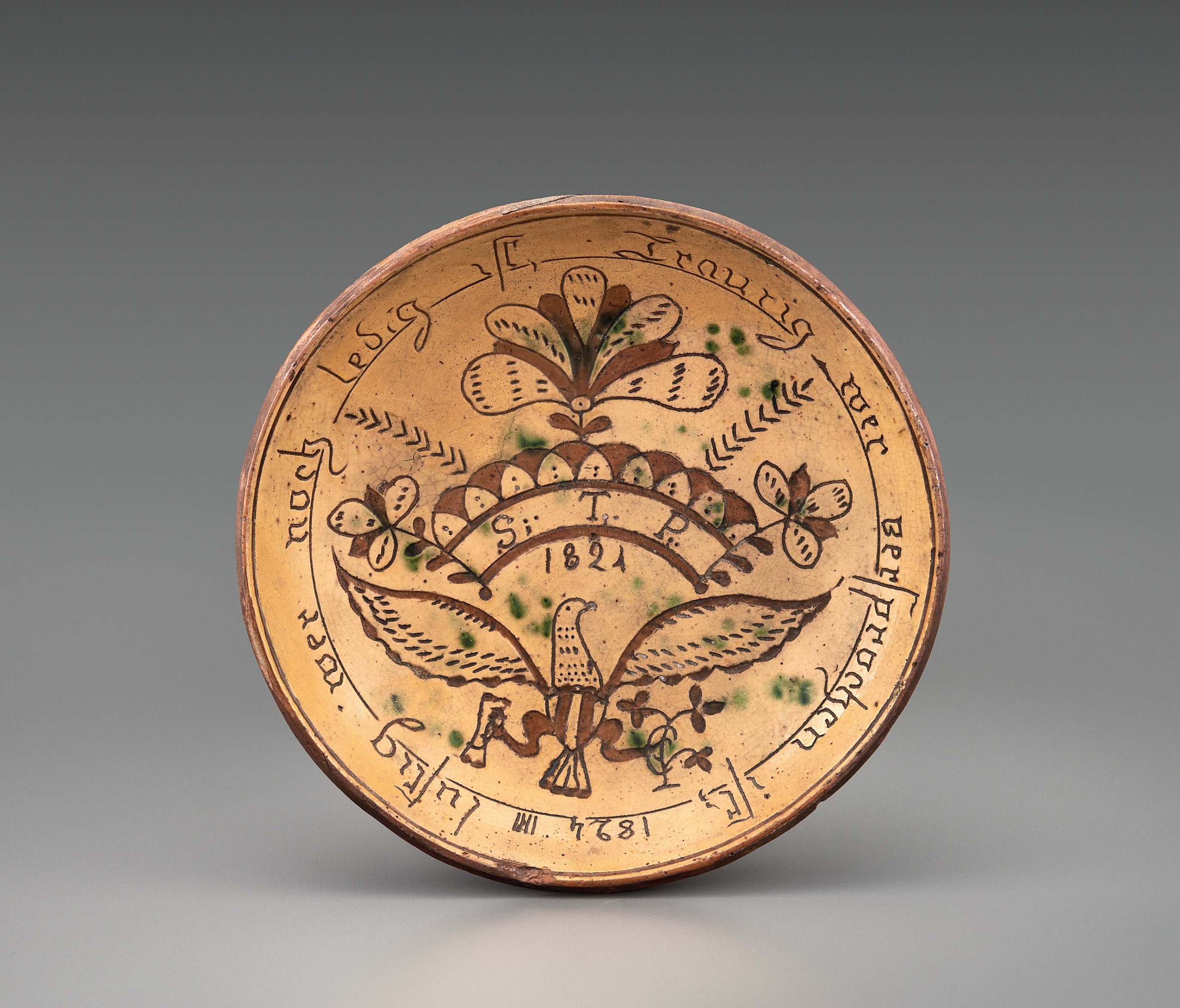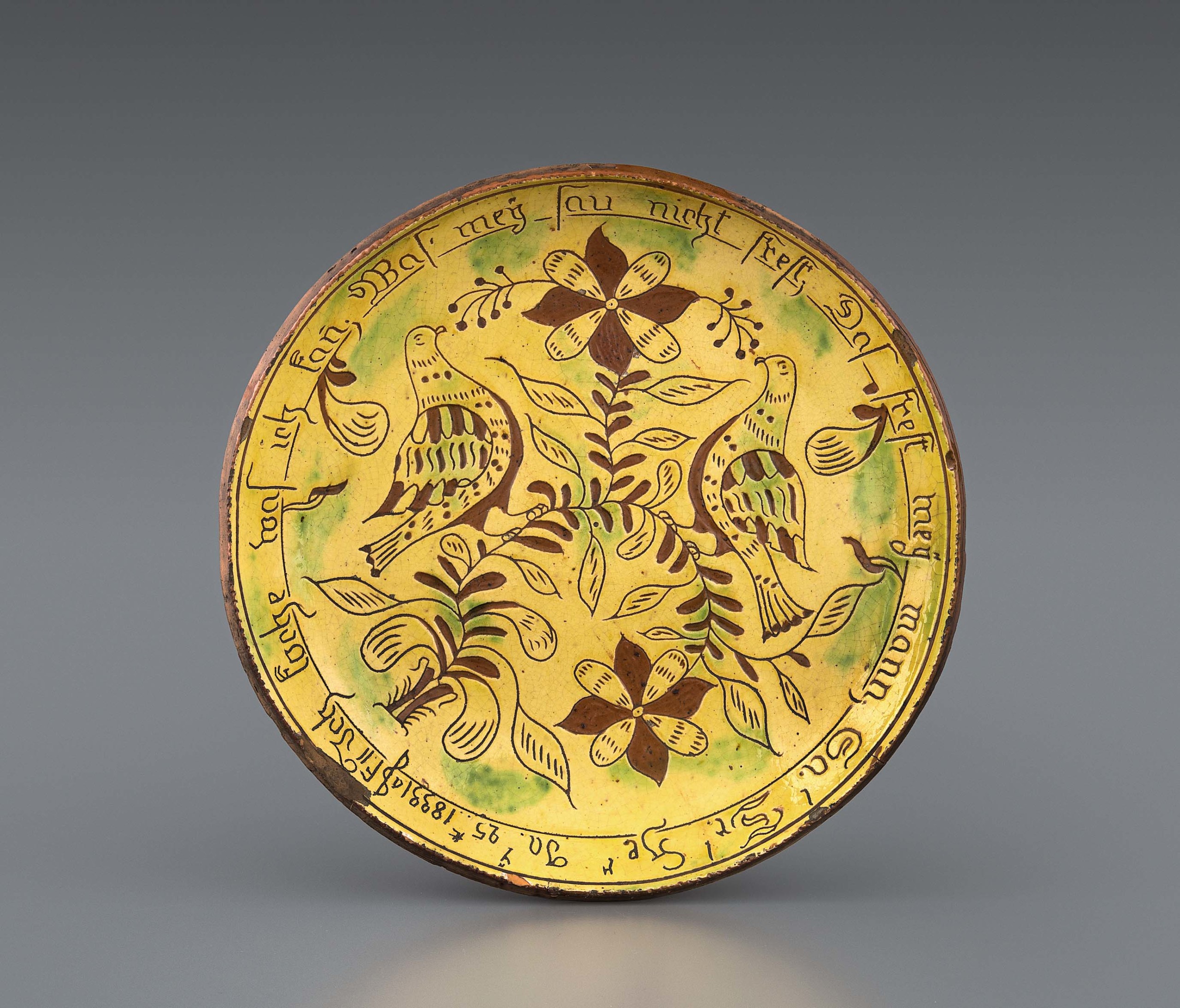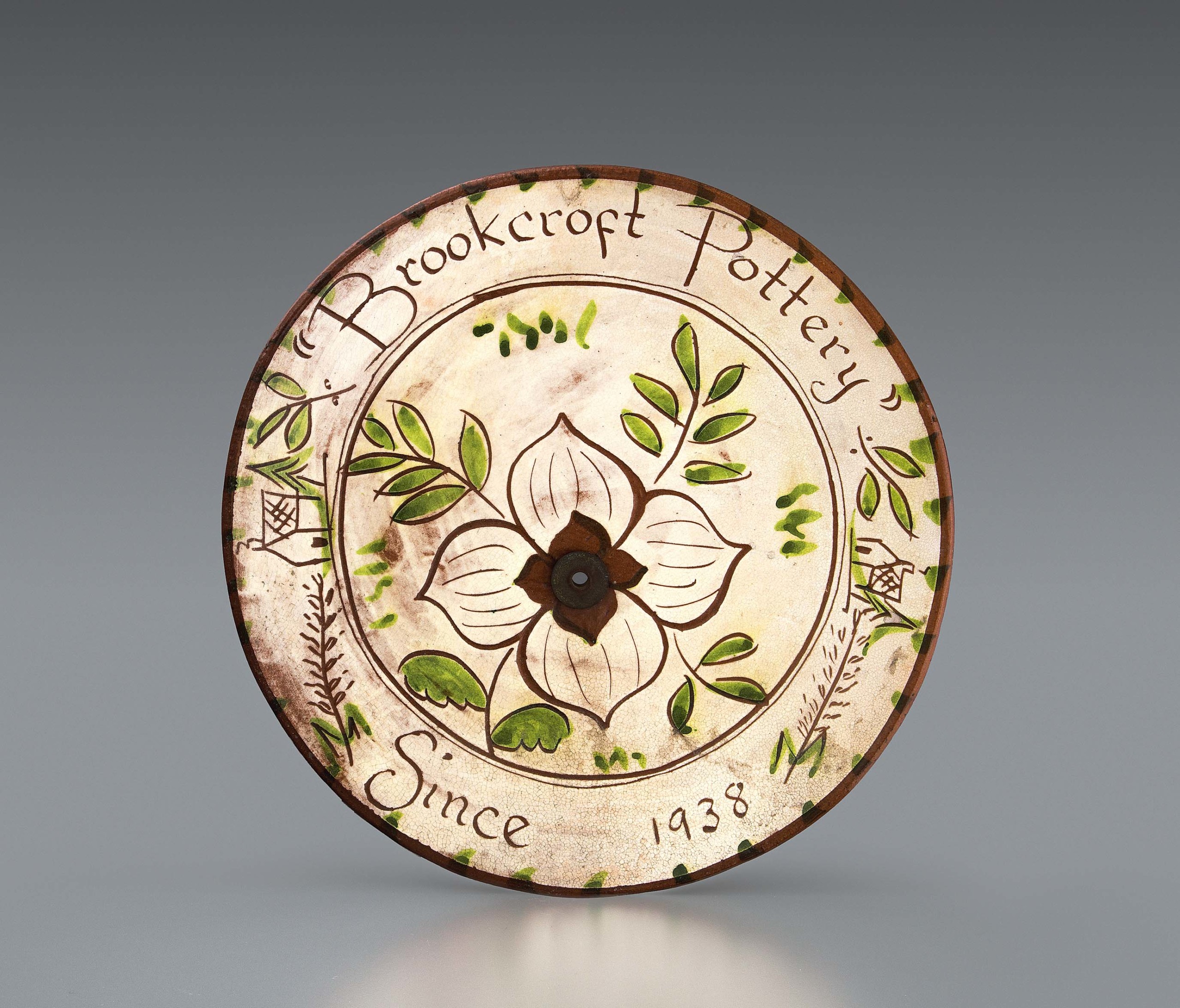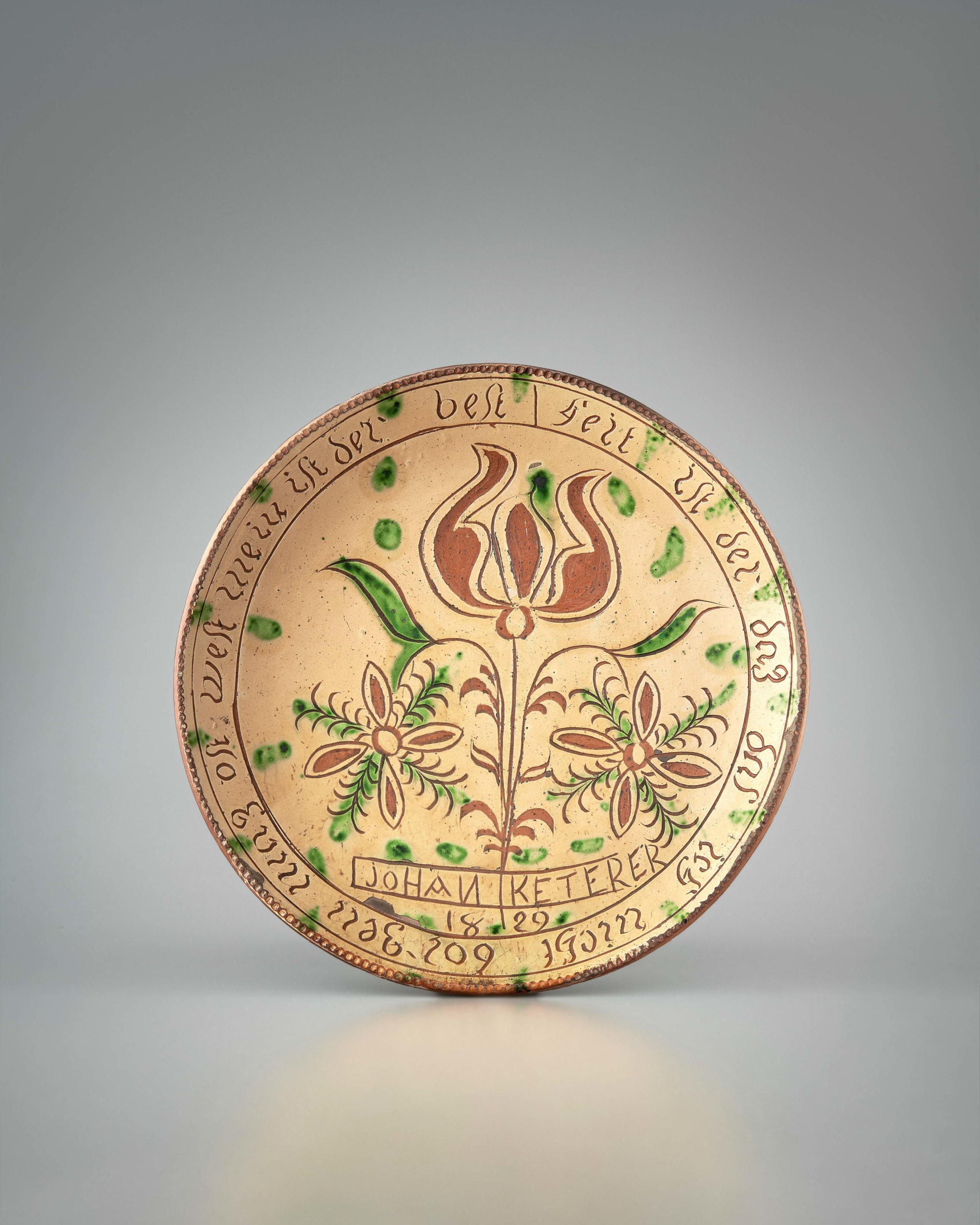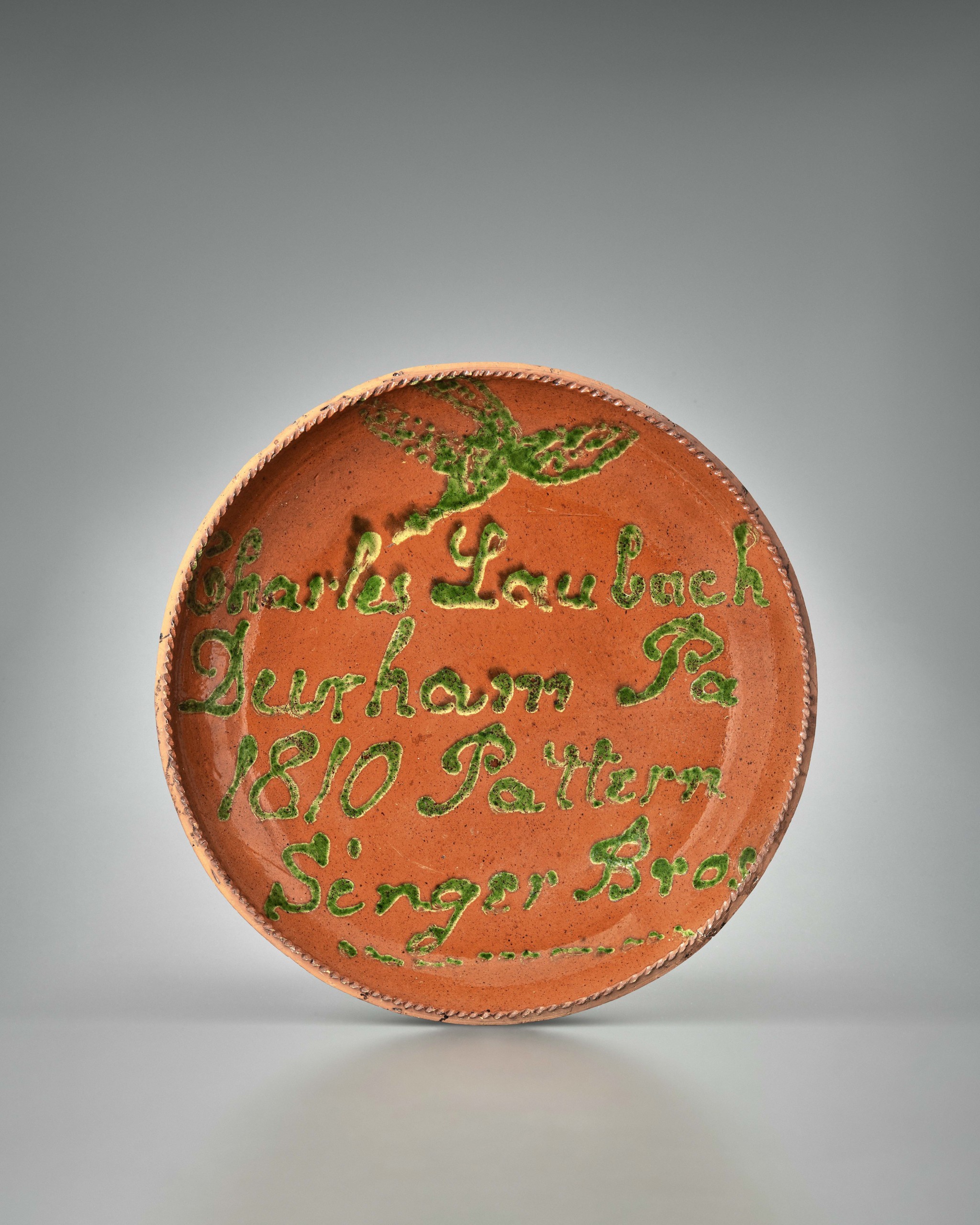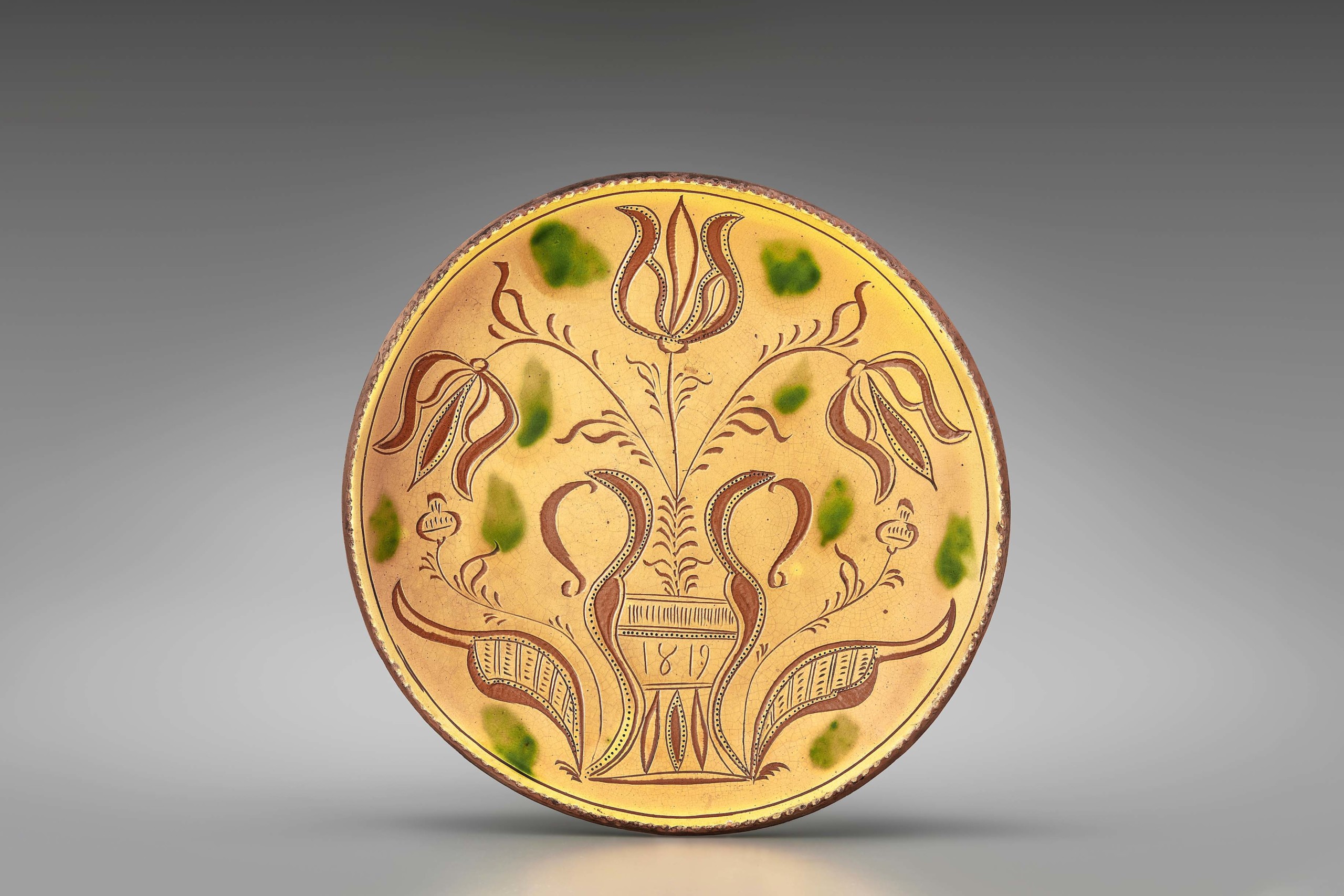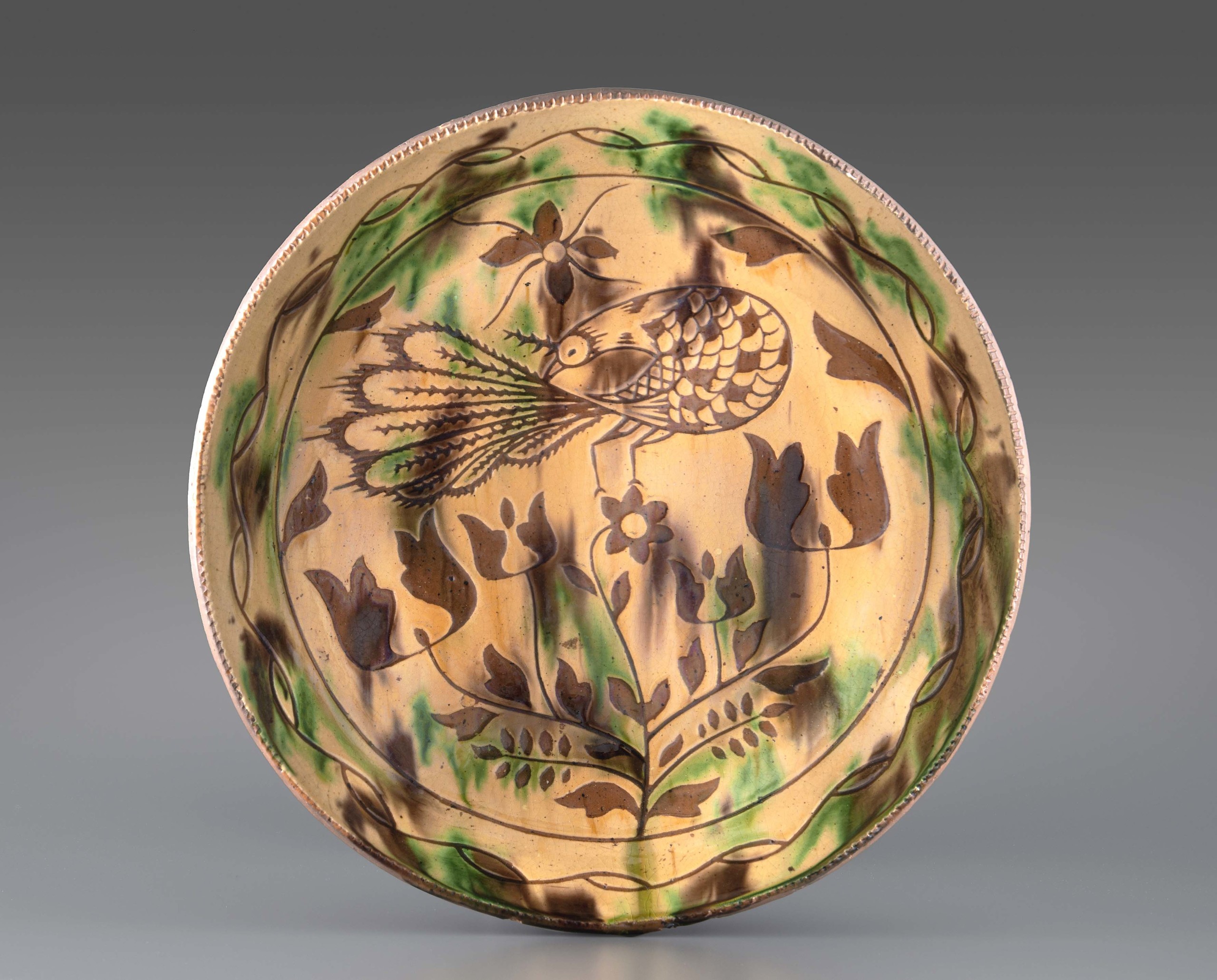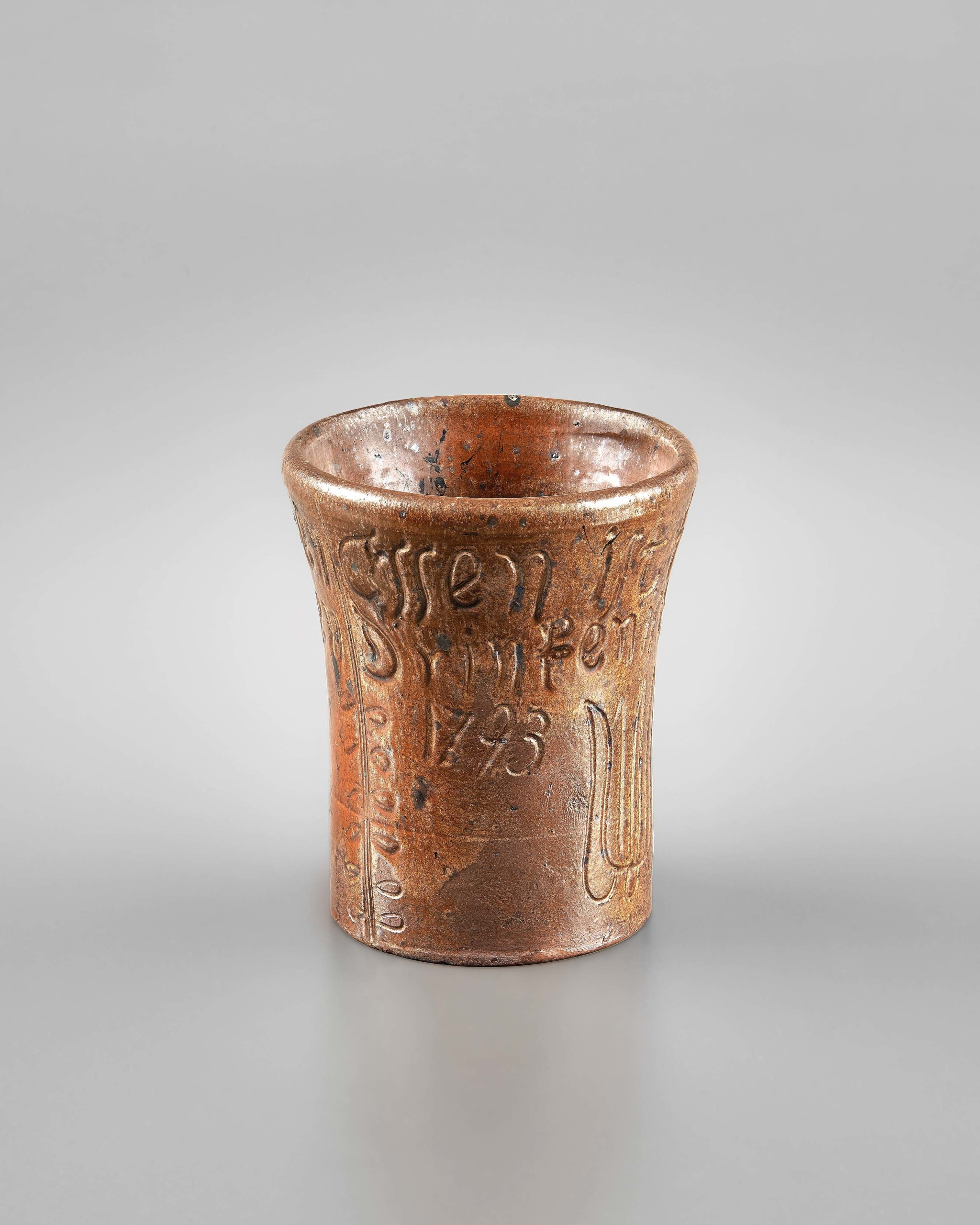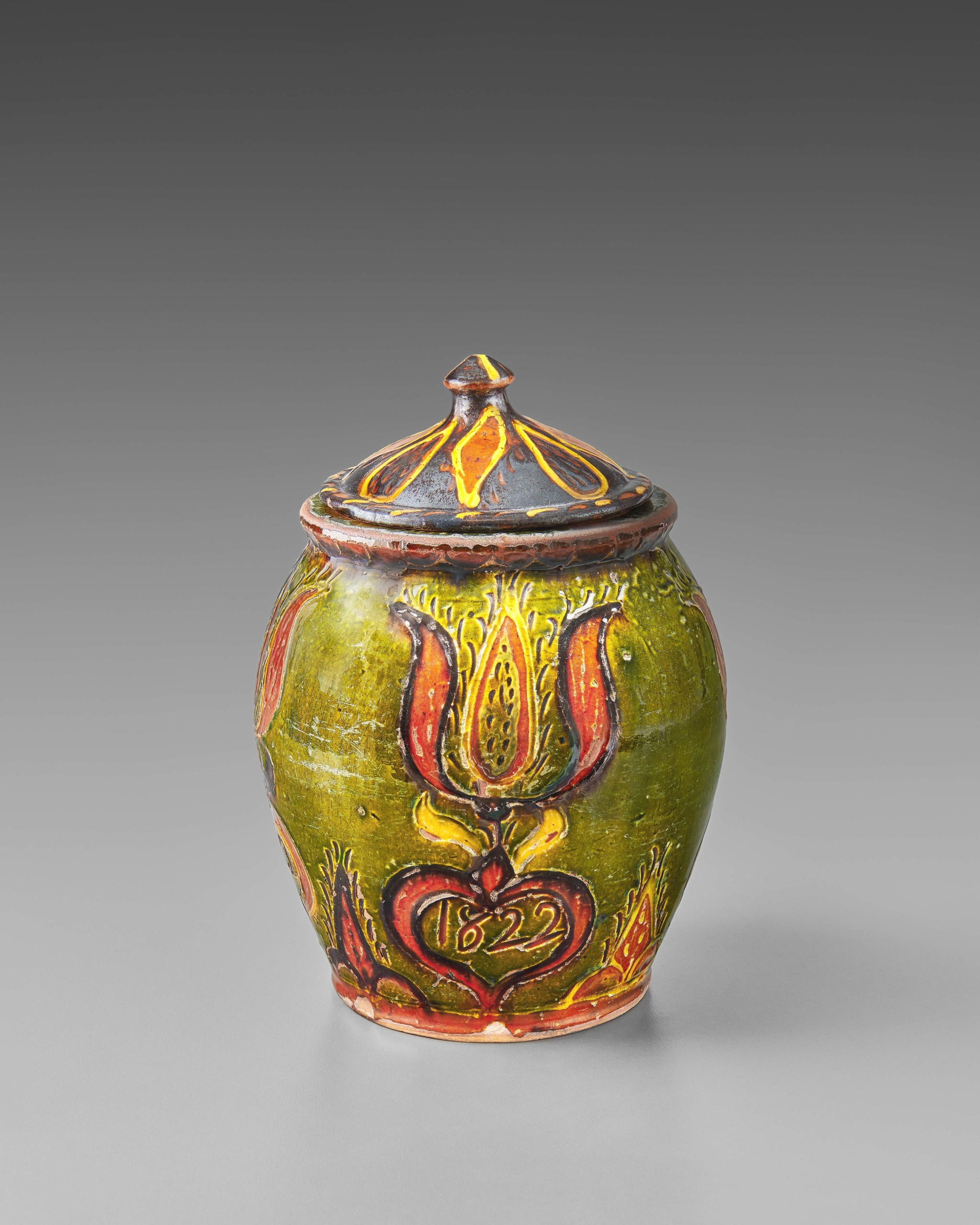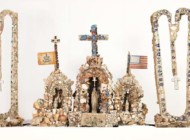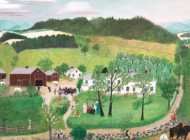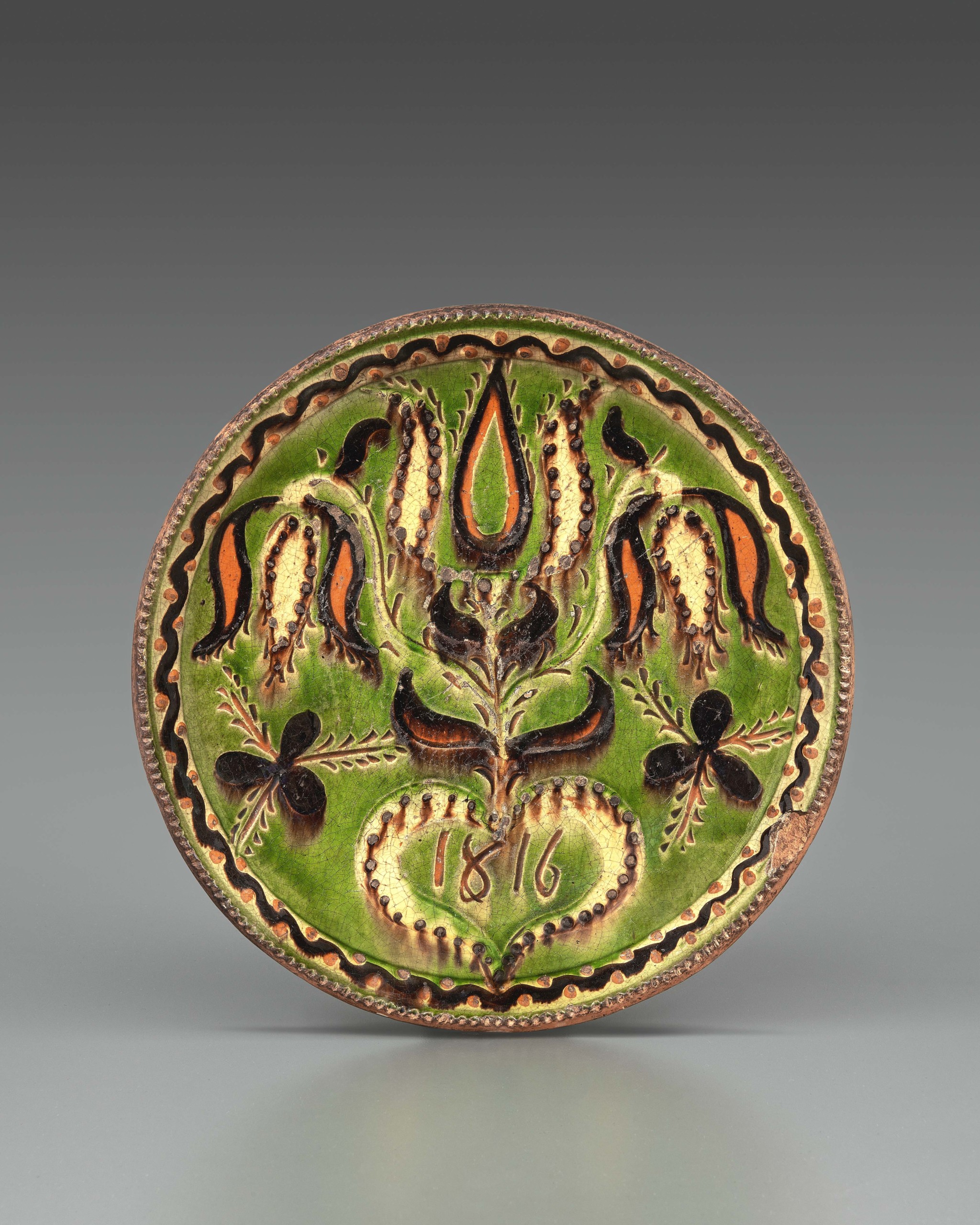
Dish attributed to the Eight-Pointed-Star Artist (formerly Solomon Grim), probably Northumberland or Union County, Penn., 1816, lead-glazed earthenware, 9⅝ inches (diameter). Franklin & Marshall College and the Phillips Museum of Art Collection, Lancaster, Penn., 5122. Michael E. Myers photo.
By Madelia Hickman Ring
TRAPPE, PENN. — Lisa Minardi, executive director of Historic Trappe, which is not only the home of a pre-1750 redware kiln (excavated in the 1990s) but is also a short distance from the potteries of two important Pennsylvania German redware potters Georg Hubener and Jacob Medinger, has long wanted to mount an exhibition on Pennsylvania German redware. With the only book on the subject being Edwin Atlee Barber’s Tulip Ware of the Pennsylvania-German Potters: An Historical Sketch of the Art of Slip-Decoration in the United States (Pennsylvania Museum & School of Industrial Arts, 1903), it was also time to update the scholarship. “From Hubener to Medinger: Redware Potters of Southeastern Pennsylvania,” on view at Historic Trappe’s Center for Pennsylvania German Studies from November 8-March 29, accomplishes both and is the first major exhibit to focus exclusively on Pennsylvania German redware. It is timed to coincide with the release of the third volume of Americana Insights, which is solely devoted to recent in-depth redware research and serves as the exhibition’s catalog. The show will open concurrent with the 62nd Annual Delaware Antiques Show, taking place at the Chase Center in Wilmington, Del., November 7-9.
Drawn from numerous private collections as well as several museums, the exhibit is organized around potters and features the work of a wide range of them, starting with Georg Hubener (1761-1835) as one of the earliest and best known of all Pennsylvania German redware potters despite a relatively short period of pottery production, from 1785-92. Only 11 plates and two jars are known by his hand; Historic Trappe owns the only signed plate made by Hubener as well as the only signed plate known by his contemporary, Johannes Neis.
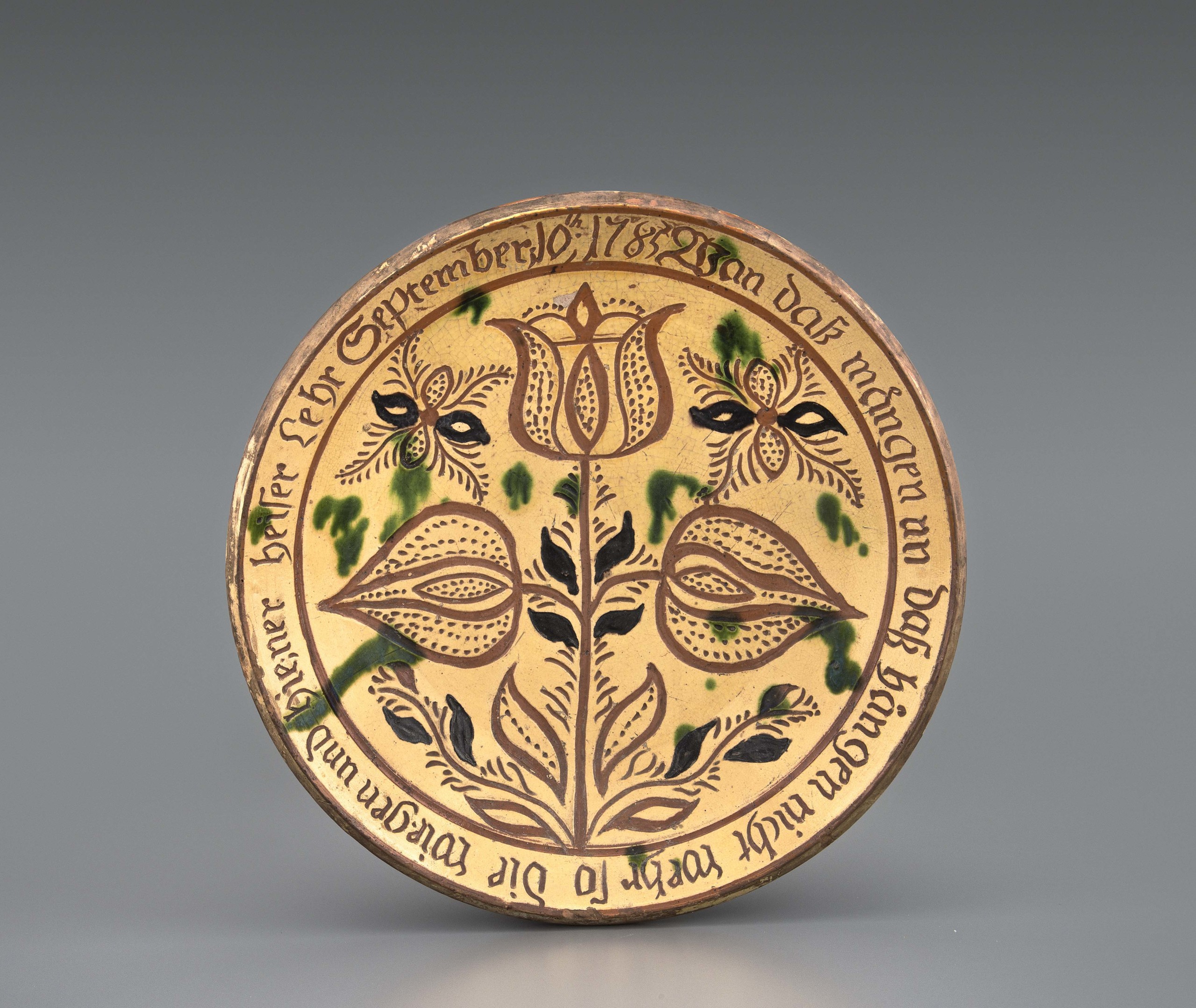
Plate attributed to Georg Hubener, Upper Hanover Township, Montgomery County, Penn., 1785, 12¼ inches (diameter). Collection of Robert and Katharine Booth. Gavin Ashworth photo.
The work of Neis and David Spinner are also featured in the exhibit; they lived on the border of Bucks and Montgomery Counties and are best known for making sgraffito plates featuring men on horseback and other Revolutionary War-inspired imagery. Potter Samuel Troxel of Upper Hanover Township, Montgomery County, is also featured, with a focus on his politically-inspired redware featuring the Great Seal of the United States.
In researching for “From Hubener to Medinger,” Minardi and her team were able to correct Hubener’s life dates (thanks to finding his gravestone), upended some attributions to Solomon Grim and realized that some pieces once believed to have been made in the late Eighteenth or early Nineteenth Century were actually the work of Colonial Revival potters.
Christopher Malone, curator at Historic Trappe, noted that many readers believed that redware pottery fell out of use by the mid to late Nineteenth Century. In fact, he notes, “redware pottery was still being consumed by Pennsylvania Germans well into the early Twentieth Century.”
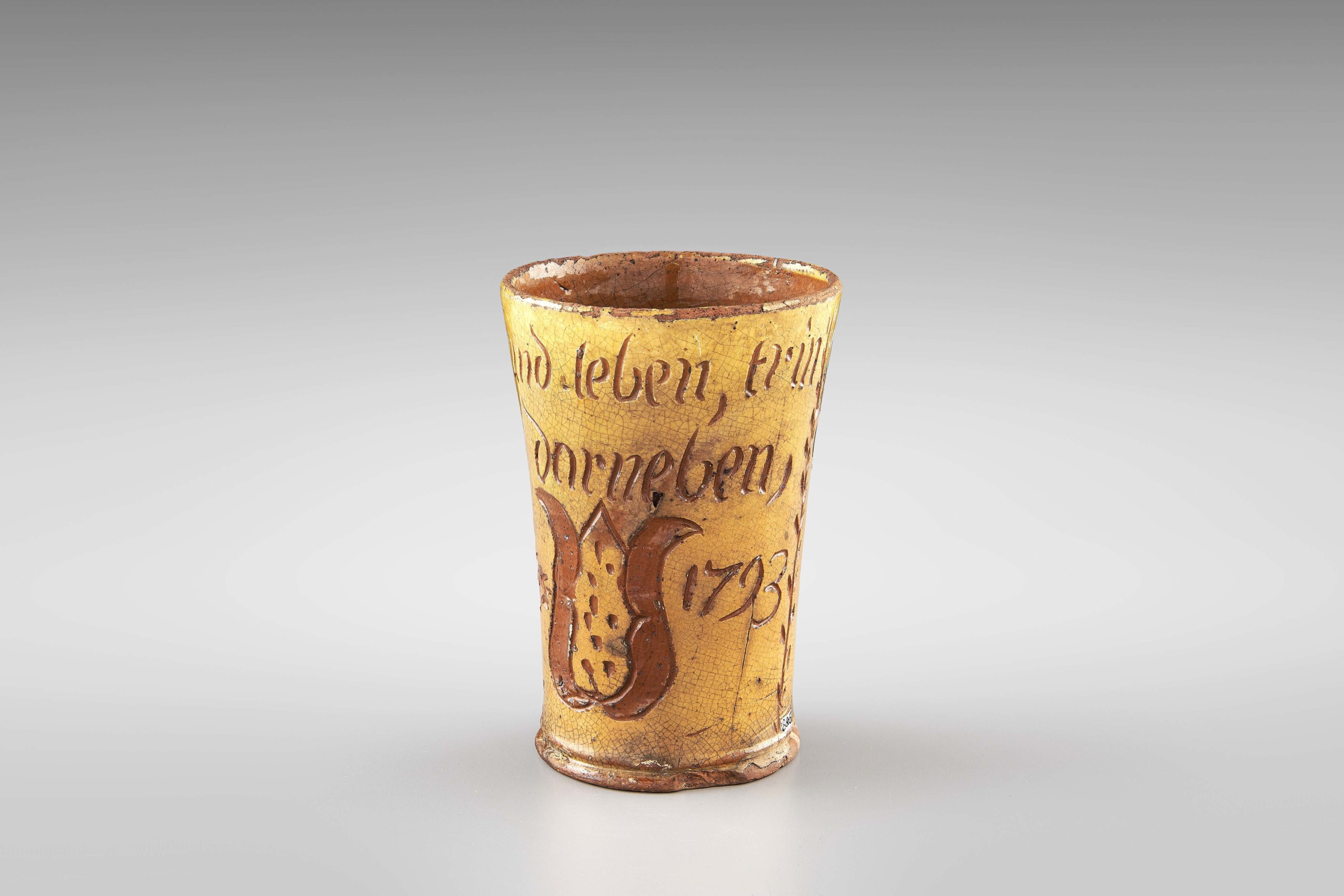
Drinking cup, southeastern Pennsylvania, 1793, lead-glazed earthenware, 5⅛ inches (height), 3¾ inches (diameter). Mercer Museum 00886. Michael E. Myers photo. Inscribed (translation): “Eating comes before love and life; drinking is also good alongside it.”
Collectors Robert and Katherine Booth, who have focused on acquiring Pennsylvania German items because they are part of her heritage, began collecting redware around 2000 and acknowledge a preference for it over the other forms they collect. Of the dozen pieces they’ve loaned to the exhibition, a 1785 plate by Hubener is both a centerpiece in the show and the cover of Americana Insights. The Booths, who told Antiques and The Arts Weekly they were “most gratified and grateful” it was on the cover, additionally noted it was exceptional for “the boldness of the graphics, the strength of the palate and the crispness of the sgraffito.”
“This [show] is not just going to be a landmark exhibition but the accompanying Americana Insights volume will, I believe, really impact the market for Pennsylvania German redware,” affirmed Virginia auctioneer Jeff Evans, whose auction house, Jeffrey S. Evans & Associates, is a presenting sponsor for the exhibition and who was given an opportunity to see an early layout. “There will be scholarship that changes what we know and how we think about these pieces. My hat goes off to Lisa and the authors; for so long, knowledge about Pennsylvania German redware has been closely guarded but it’s now coming to light. It’s very exciting.”
Among those whose research has helped rewrite previously believed facts is Jean D. Renshaw, whose “Hunting Scene Inkstands by Frederick Pflüger and a New Look at David Haring’s Pottery” is one of four briefs included in Americana Insights. Because of her research, an inkstand in the Booth’s collection, which was once owned by Jonas Haring (1841-1931) and believed to have been made by David and Jared Haring can now be more correctly attributed to Frederick Pflüger based on its inscribed initials “FP” and similarities to one in the collection of Winterthur Museum that is inscribed “Frederick Pflüger.”
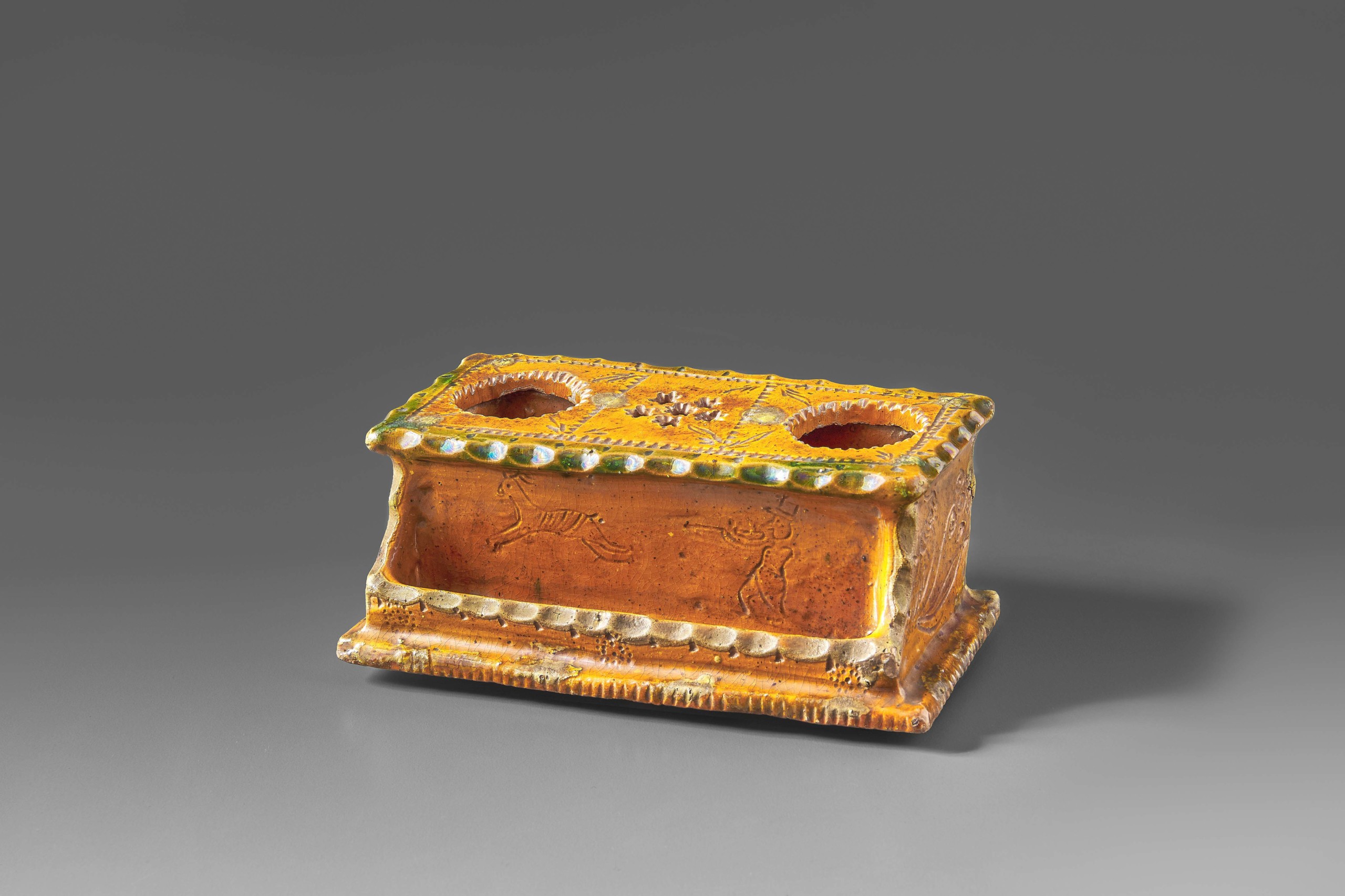
Inkstand for Jonas Haring, attributed to Frederick Pflüger, Hoppenville, Montgomery County, Penn., 1853, lead-glazed earthenware, 2¾ inches (height) by 6¾ inches (width). Collection of Robert and Katharine Booth. Michael E. Myers photo. This inkstand was previously attributed to David and Jared Haring.
Jean and her husband, John, whose shared passion for redware began early in their marriage with the purchase of an early Chester County house, also underscored the importance of this show. “We’ve been collecting redware for more than 40 years; it’s beyond our comprehension that it will be only the second exhibition to focus on [it]. It’s a once in a lifetime opportunity to see really rare and special pieces from that area and time,” they told us. “If it helps revitalize the interest in Americana, what more could we ask for. We hope collectors and the public realize how special this exhibition is.”
“From Hubener to Medinger: Redware Potters of Southeastern Pennsylvania,” will be on view at Historic Trappe’s Center for Pennsylvania German Studies from November 8-March 28.
The Dewees Tavern at Historic Trappe is at 301 West Main Street. For information, 610-489-7560 or www.historictrappe.org.

